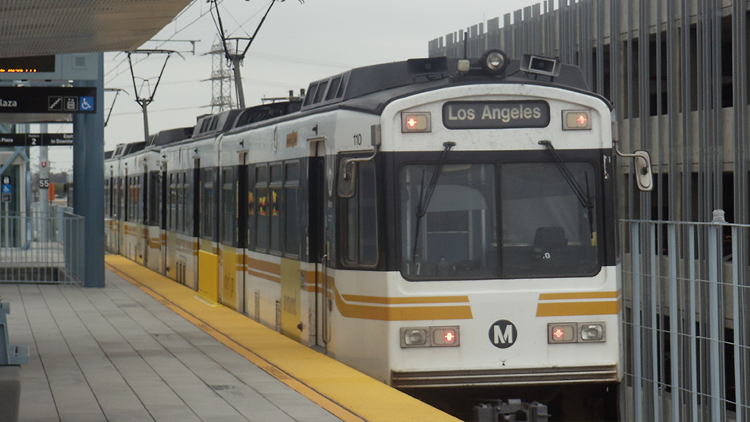The Challenge
Vehicle emissions and the resulting air pollution are notable public health concerns in the Los Angeles region. The vast majority of trips in the County are by means other than public transit. One barrier to transit ridership is the distance to a rail or bus system. Factors like sidewalk availability, safety and exposure to heat make traveling to transit stops more difficult, and the effects are more pronounced amongst the elderly and those with disabilities. Ride-hailing services or “Transportation Network Companies (TNC)” like Uber and Lyft can improve access to transit by connecting users to rail or bus stations that are beyond walking distance. Realizing the potential of TNCs, this study proposed combining them with zero-emission vehicles to ultimately reduce emissions, encourage public transit use, and support L.A. County’s ongoing initiatives to reach 100% renewable energy and reduce air pollution.
The Solution
Shared TNC service via zero-emission vehicles to and from major transit stops during commutes in metropolitan L.A. is proposed as a viable solution to promote both zero-emission vehicles and public transit use. The research project examines whether and to what extent TNCs, along with air quality and trip reduction regulations, might accelerate the deployment of zero-emission vehicles in the area. Researchers conducted assessments in transportation planning and of the business models of TNCs operated using zero-emission vehicles. The rules and implementation plan of the South Coast Air Quality Management District (AQMD)'s employee commute reduction program are also evaluated. In April 2018, the researchers published their final report, which includes economic, regulatory, and planning-related findings, along with recommended public sector actions.
Results
- Planning assessment finds there is a high potential for passenger-matched rides (where multiple passengers will share an origin or destination) serving more than 400 linked TNC-transit-walking trips less than 45 minutes in duration. The stations closer to central Los Angeles and downtown tend to be more likely to have a high potential for a match.
- Regulatory assessment finds that as of model year 2018, only three vehicles sold in the United States had a capacity of at least six adult passengers and are able to partially operate in zero-emission mode. Only one of these vehicles exclusively operates in zero-emission mode. Given this context, encouraging people to use TNC travel to transit stops is easier than inducing 1) TNC trips on zero-emission vehicles and especially 2) TNC trips to transit stops on zero-emission vehicles. This approach is currently in operation by L.A. Metro via its Mobility-on-Demand program.
- Findings from both regulatory and market assessments suggest subsidizing TNC leases can introduce more zero-emission vehicles. Researchers recommend TNCs to directly subsidize zero-emission vehicle leases: providing targeted bonuses to TNC drivers who complete threshold of weekly trips using a zero-emission vehicle and invest in refueling infrastructure.
Next Steps
Researchers created a concept of a new commuter product that could eventually be marketed county-wide at the discretion of Metro, companies like Uber and Lyft, and commuter benefits administrators. Additionally, the work has already informed 1) below and will continue to inform the following 2) through 4) strategic projects/regulatory processes in L.A. County:
- L.A. Metro's 12-month Mobility-on-Demand pilot project linking transit stations and ride-hail vehicles.
- Creation of a potential "green commutes" product that bundles ride-hailing and transit pass.
- Future updates to the AQMD's Rule 2202, designed to reduce emissions caused by employee commute.
- A growing trend of cities looking to establish their own local transportation demand management ordinances, which often include local enforcement of Rule 2202.
Additional Outcomes to Date
Evelyn Blumenbergfrom the UCLA Institute of Transportation Studies (ITS) received funding from the Los Angeles Department of Transportation to evaluate federally funded innovative mobility projects. Michael Manville, also an ITS faculty member, received funding from the United States Department of Transportation to evaluate L.A. Metro’s Mobility-on-Demand pilot project. Co-Principal Investigator Juan Matute was involved in securing these funds to build on the original research project. L.A. Metro continues to use recommendations in informing its Mobility-on-Demand Program that allows sharing transportation to MetroRail stations. The agency is working on developing marketing strategies to encourage repeat users of the program.
Publications and Reports
Incentivizing Zero-Emission Vehicle Ride-Hail/Public Transit Commutes in Los Angeles

Topics
Research Team
Brian Taylor
Urban Planning and Public Policy, Luskin School of Public Affairs
Institute of Transportation Studies
btaylor@ucla.edu
Juan Matute
Institute of Transportation Studies
jmatute@ucla.edu




